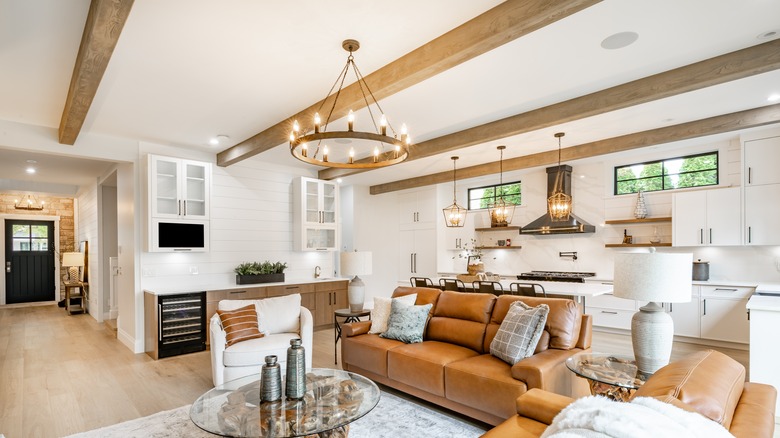What To Consider Before Creating An Exposed Ceiling In Your Space
Do you love entering an older building and seeing exposed beams or pipes that transport you to a different time and space — one where wood supports reigned supreme and industrial aesthetics were the norm? There is something so versatile about a home or venue that features an exposed ceiling, offering a glimpse behind the metaphorical curtain to the bones of the building. Maybe it stirs something nostalgic in you (exposed wood beams in a cozy cabin) or inspires your creative side (think of all the industrial-style decor that could complement those exposed pipes!). If you love this trend, you're not alone. In fact, you might be seeing more of it in 2025. From amping up your bedroom ceilings to adding depth and dimension to a living or dining room, this aesthetic offers a creative and chic way to upgrade boring designs.
During an exclusive interview with House Digest, architecture and design historian Sarah Bilotta explained the advantages and disadvantages of an exposed ceiling. "An exposed ceiling is a fantastic way to evoke a utilitarian, industrial feel," she said, noting that brutalist architecture uses these pieces to show off a building's engineering. "This aesthetic is also used to communicate unpretentiousness: it leaves the interior workings of the building exposed for all to see," she explained. These advantages are reason enough for some to leave their ceilings in a more "natural state." According to Bilotta, this design can also create an "extended sense of vertical space" while also preserving some of the building's history and character.
The drawbacks of exposed ceilings
There are many advantages to leaving an exposed ceiling or creating one within your home. And while these alone may sway you, it's imperative to understand some of the drawbacks that come with this trend. During her exclusive talk with House Digest, Sarah Bilotta explained that temperature is a big player in homes with exposed ceilings. "An exposed ceiling leaves no insulation between you and the elements," she said. "If you try to heat that space, most of the warm air will simply escape." She went on to say that if the room is connected to others without insulated layers (like walls), heat will tend to escape from the adjacent areas through the exposed ceiling. Ditto for outside heat when the weather is warm. "It can also get extremely hot in the summer, with the sun beating down on the roof and heating that room," Bilotta added.
If heating and cooling costs are already a big concern or you don't want to pay more to maintain temperature in rooms with exposed ceilings, this might be a big factor in your decision. The last thing to consider is the effect these ceilings will have on resale value of the home. While many people covet exposed beams or pipes, some find them unappealing and may forgo a home because of them. "Some people find exposed pipes to be ugly and the look to be unfinished," Bilotta explained, so keep this in mind if you're not thinking of this abode as your "forever home."
Consider your needs, both financially and design-wise
So how do you decide if exposed ceilings are not just a good idea for your home, but also feasible? If you're renovating an older building and want to tap into the industrial aesthetic, exposed beams or pipes are a no-brainer. For larger buildings, Sarah Bilotta also has an exclusive tip for House Digest readers. "If you're renovating an industrial building, this also means you don't have to insulate the ceiling, which is a major money-saver," she explained during her interview. But she cautioned that this comes at a price: Your heating and cooling bills.
Bilotta acknowledged that while the results of an exposed ceiling are definitely eye-catching, it isn't the most practical option for everyday homes. "The cost trade-off is dramatic," she warned. "You could easily be losing hundreds of dollars per month on heating costs during the winter, depending on the size of the room." She stressed the importance of considering your long-term budget and whether you can afford the energy costs associated with your climate. "If you live in an area with especially cold winters, your heating costs will be higher," she noted. "Additionally, snow and ice will build up and can create ice dams on the roof, leading to structural problems."
If it doesn't work to have exposed statement ceilings in every room or even the main ones, Bilotta suggests considering "a "three-season" room with an exposed ceiling that is sealed off and not used during the winter. "[Lastly] consider how much the rest of your decor and the aesthetic of your home will depend on the look of an exposed ceiling," she added.


